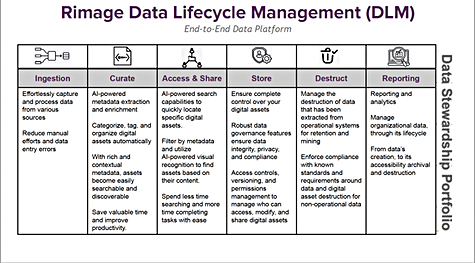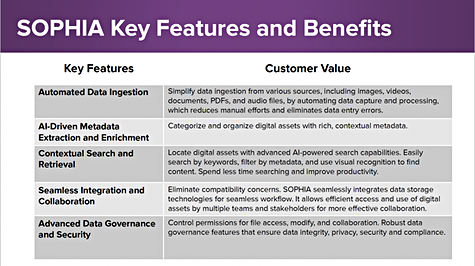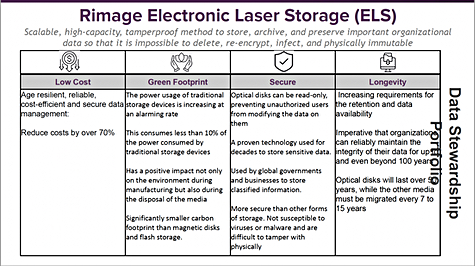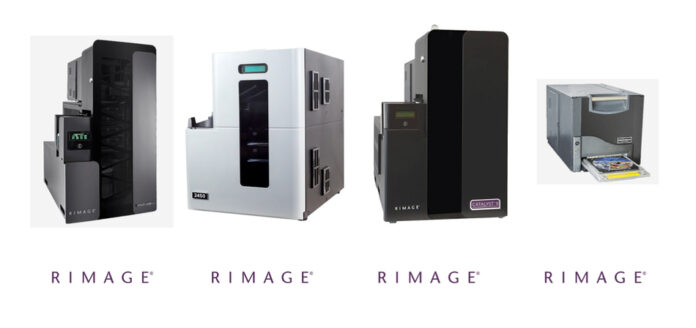Established optical disc-based archiver Rimage is pivoting to data management with an AI-powered digital asset metadata extraction and search product announced, and advanced optical storage in its roadmap.
Rimage describes itself as a global leader in on-demand enterprise and consumer digital publishing to CD, DVD, and Blu-ray discs and USB sticks with 194 channel partners and over 20,000 systems installed by more than 3,000 customers in law enforcement, government, manufacturing health and finance. It has just launched its SOPHIE digital lifecycle management system and has an Electronic Laser Storage (ELS) initiative underway focussed on emerging optical disk technology. Rimage presented its SOPHIA product and ELS plans to an IT Press Tour in Silicon Valley in January. Before we examine these it is instructive to understand Rimage’s history and grasp a key takeaway.
Rimage history
It was founded in 1987 as IXI inc. in Minnesota, with its founders having bought floppy disk manufacturing assets from the previous owner. This evolved into CD-ROM printing, with colored cartridge labels and also direct thermal printing in the disks, and CD-R and DVD-R duplication equipment. Rimage went public in 1992. The diskette business became loss-making after 1995 and it put its main focus on the duplication systems, and full-color images on CDs. DVDs came along in 2000 and Rimage produced DVD burners and photo-quality printing systems for opticaldisk labels. High-definition Blu-ray disk support was added in 2007. It acquired Qumu in 2011 for $57 million to enter the enterprise video content industry. Rimage changed its name to Qumu in 2013 but then ran into problems with its declining disk publishing business while the video content business had healthy prospects.

Qumu Corp sold its Rimage assets to private equity business Equus Holdings in 2014 for $23 million, with Equus ressurrecting the Rimage name. It did not prosper as well as hoped and Christopher Rence was appointed Rimage CEO in 2020 to continue an ongoing transformation. The pivot to digital data asset management is taking place as part of Rence’s strategy and product line restructuring. COO and CRO Rick Bunce told the Press Tour audience that, like Smith Corona with its typewriters, Rimage had to change. It has been retreating from some verticals – eg finance – as its product offer stagnated, and needs new products.
The takeaway to bear in mind is this: Rimage has always been about the production of disks – from floppy disks through CDs and DVD to Blu-ray disks. Although it uses optical disks for archiving data it has not been involved with archiving per se, specifically with archiving software and archiving data to tape. Its DNA is centered on disks and not ribbons – of digital tape. SOPHIA could change that.
The pivot
Bunce told the Press Tour that AI is a new trend, some of which is LLM (Large Language Model)-based and other purpose-built AI. He identified AI that is used for storage, and storage that is used for AI, and asserted that purpose-built AI is what’s going to matter and machine learning is key.
Rimage’s broader strategy has hardware (Enterprise LaserStorage) and software (Data Lifecycle Management) elements that help customers to manage data from birth to destruction. Rimage now sees itself as a digital steward and thinks the data lifecycle management (DLM)/document asset management (DAM) market is fragmented with many suppliers and no one dominant vendor. That means a new entrant can prosper.

it has two product categories in its data stewardship portfolio: DLM and ELS. SOPHIE is the first product in the DLM area and is AI-powered.

SOPHIA
SOPHIA is from the Greek for knowledge and wisdom. Rimage’s product is the first of a set of modules, software abstractions above storage hardware, and is concerned with Digital Asset Management (DAM).
Rimage claims it seamlessly automates data ingestion from any source and builds a global repository to organize and optimize digital assets in a streamlined and secure way. The product uses AI to help it extract and generate contextual metadata from ingested digital assets and users can also customize filter fields, upload requirements and workflow controls to make its operation more efficient. Search is AI-powered with metadata filtering capabilities. There are permissions controls to help with security and governance features to aid compliance.

SOPHIA has file syncronization features to make files available to any location, whatever the network connection, syncs all changes back to the SOPHIA library. It works with any native Windows or OSX (macOS) application, eliminating any need for plug-ins or third-party applications. Linux support is coming.
SOPHIA integrates into all of the Rimage family of products and supports Al–driven data management.
The software is not entirely home-grown. Bunce explained: “We use a number of partners bringing infrastructural software into Sophia. We buy or license it and build on top of that. … We will slot the new software into our existing management layer.” One its partners is Germany-based PoINT Software which produces archive software, including software moving archive data to object storage on tape.
SOPHIA covers part of the DLM feature set. Rosen said Destruct (data destruction) is coming soon and Rimage is working hard on developing deeper analytics.
The product uses Google Vision AI and Rimage has written some of its own AI software.
SOPHIA is data agnostic, supporting file, block, object, structured and unstructured data. It has customizable AI features,an API, and flexible deployment, either on-premises, as SaaS or in hybrid form. SaaS SOPHIA can use Azure or AWS or horizontal/vertical MSPs.
ELS
The term ELS, Electronic Laser Storage, refers back to Rimage’s CD/DVD/Blu-ray heritage as all these optical disk drives use lasers for reading and writing. Their use in archiving is falling away because of capacity limitations. Enterprise sales director Jeff Rosen noted: “Blu-ray has a maximum of 200GB/disk. It needs increasing and the density will scale.”
Optical disks can last for 50 years and complement LTO tape by having better (faster) random data access. Tape is not actually physically immutable, Rosen explained, being subject to EMPs (Electro-Magnetic Pulses). Optical disk is a safer medium in this regard. He also observed: “China has a mandate that all of its archive data will be optical disk in five years and not tape [and] China will effectively restart an optical disk industry. A Chinese company is building what we’re doing.”
Also Rosen and Bunce revealed multi-layered optical disk density improvements are coming from suppliers such as Sony, Folio Photonics, and Pioneer. In other words, optical disk is going to make a comeback. But these products don’t exist yet.
He dismissed Microsoft’s Project Silica though, saying: “Microsoft has abandoned glass – it’s buried maybe in R&D.”

Comment
The ELS product, when it arrives, being optical disk-based will provide an upgrade path for Rimage’s installed base of >3,000 customers with 20,000 or so optical disk printing and publishing machines.
The general theme of DLM and archiving software is that it is media-agnostic. Digital archives can live in tape libraries, on optical disk, even on spun-down disk, or on whatever devices are used by the public clouds underneath their S3 or Blob storage abstractions – be they disk or tape.
Based on this thought, Rimage could embrace LTO tape technology, also object-to-tape technology, and set up alliances with tape library system vendors such as Quantum and SpectraLogic. It should perhaps join the Active Archive Alliance and learn what the archive software players are doing.
Yes, the data lifecycle management market is fragmented, with players including Komprise, Datadobi, Data Dynamics, SpectraLogic, Arcitecta, Quantum, and StorMagic. But it is also quite mature in a software sense. We can expect all the existing archive software system players to add AI features to their products, with AI becoming table stakes. It is already happening in the data protection market. On the hardware side, new glass-based media technologies will likely come along, but the archive storage software layer will adapt to them and not be revolutionized or replaced.
If Rimage now sees itself as a data lifecycle management steward then turning its face away from the tape archive system market may seem like it is deliberately missing an opportunity.
Bootnote
Rimage has a range of additional products, which include:
- Rimage Protection Shield for cyber security;
- Rimage Data Solutions to gather and ingest digital assets from various devices onto multiple storage platforms;
- Rimage Data Preservation for long-term retention.








